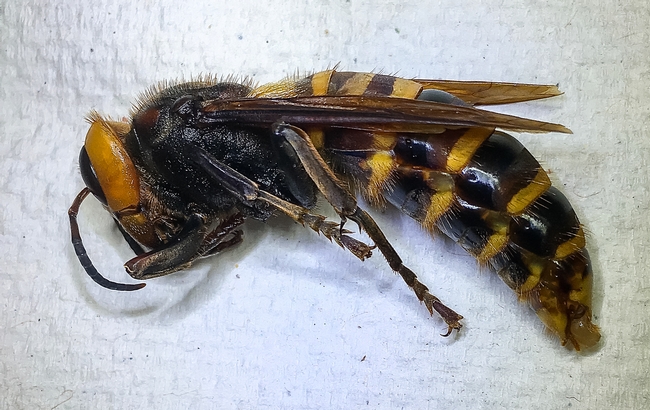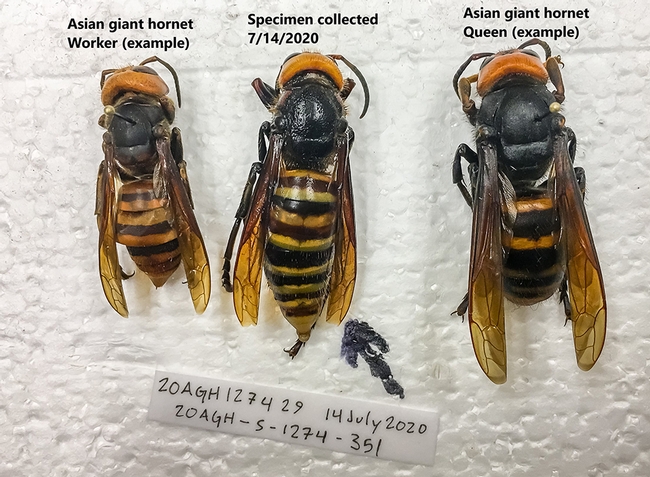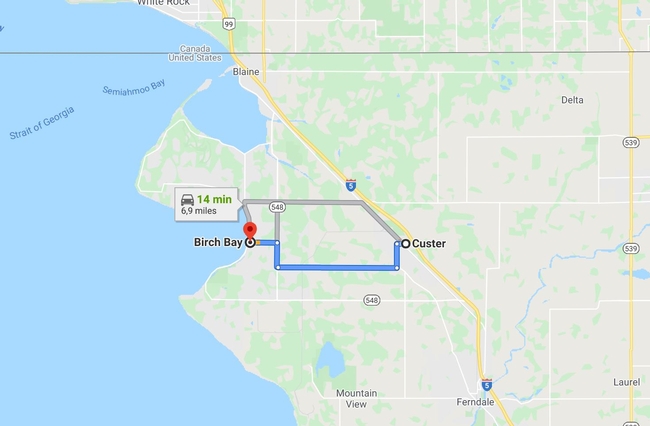Just when folks were beginning to think "it may be over and done" regarding Asian giant hornet sightings, it's not.
The Washington State Department of Agriculture (WSDA) has just trapped its first Asian giant hornet, Vespa mandarinia, which the news media dubbed "the murder hornet." (It's a name that makes entomologists cringe.)
In a news release published July 31, officials announced that they found a hornet in a WSDA trap set near Birch Bay in Whatcom County. "WSDA trappers checked the bottle trap on July 14 and submitted the contents for processing at WSDA's entomology lab. The hornet was identified during processing on July 29. This was the first hornet to be detected in a trap, rather than found in the environment as the state's five previous confirmed sightings were."
Sven Spichiger, managing entomologist for the department, said: “This is encouraging because it means we know that the traps work. But it also means we have work to do."
So WSDA will now use infrared cameras and place additional traps in the area. These are special traps to catch them alive. From the press release: "If they catch live hornets, the department will attempt to tag and track them back to their colony. Once located, the agency will eradicate the colony."
"WSDA hopes to find and destroy the nest by mid-September before the colony would begin creating new reproducing queens and drones. Until that time, the colony will only contain the queen and worker Asian giant hornets. Destroying the nest before new queens emerge and mate will prevent the spread of this invasive pest."
All in all, WSDA, citizen scientists and others have set out more than 1300 traps in Washington state.
"Those interested in trapping can still build and set traps on their own property," according to the news release. "Traps require weekly bait replacement and a commitment to mail the trap contents to WSDA if bees or wasps are collected. If a citizen scientist traps a live Asian giant hornet, they should call the WSDA Pest Program hotline at 1-800-443-6684."
"Because the number of Asian giant hornet workers increases as a colony develops, residents should be most likely to see an Asian giant hornet in August and September. If you think you have seen one, report it at agr.wa.gov/hornets. Provide as much detail as you can about what you saw and where. Also, include a photo if you can safely obtain one, and if you come across a dead specimen keep it for potential testing."
Noted hymenopterist Lynn Kimsey, director of the Bohart Museum of Entomology and professor of entomology at UC Davis, has been following the confirmed and unconfirmed sightings and recently talked about the Asian giant hornets on a podcast with urban entomologist Michael Bentley on his BugBytes podcast. Click here to listen.
Bentley serves as the director of training and education for the National Pest Management Association (NPMA), headquartered in Fairfax, Va., and hosts NPMA's BugBytes. Kimsey, a global authority on wasps, bees and other insects, is a two-term past president of the International Society of Hymenopterists.
They talked about the history of the hornet, its biology, its range, its behavior, its stings, and the news media frenzy.
What was known then: two incidents occurred in North America last year. A single colony of the Asian giant hornet was found and destroyed Sept. 18, 2019 in Nanaimo, Vancouver Island, Canada, and a single dead hornet was found Dec. 8, 2019 in nearby Blaine, Wash. Kimsey says they probably hitchhiked on a cargo ship,
Asian giant hornets, originating from Asia, can decimate a honey bee colony, and the Washington beekeeping industry is concerned that these invasive pests may become established here.
Meanwhile, many so-called "murder hornets" have turned out to be yellow jackets, European paper wasps, hover flies, hoverflies, moths, circadas and even a Jerusalem cricket (potato bug). Stephane De Greef, a Belgium-born entomology advocate, traveler, field guide, and photographer, earlier called the frenzy "a bloody dumpster fire." He launched a fun (and informative) Facebook page, Is This a Murder Hornet?" In a Facebook comment today, he pointed out that the findings are all within a 10-mile radius (see the map he posted below).
More information:
- Visit the WSDA website at agr.wa.gov/hornets to learn more about Asian giant hornets.
- Submit questions to the WSDA Pest Program at hornets@agr.wa.gov or 1-800-443-6684.
- View the WSDA press conference on YouTube.
Attached Images:

This is the Asian giant hornet trapped July 14 at Birch Bay, Whatcom County, Washington. (Photo courtesy of Washington State Department of Food and Agriculture)

These Asian giant hornet images from the Washington State Department of Agriculture shows (from left), an example of a worker; the specimen collected July 14; an example of the queen.

This map on Stephane De Greef's Facebook page, "Is This a Murder Hornet," shows the 10-mile radius where the Asian giant hornets were found. (Map courtesy of Stephane De Greef)